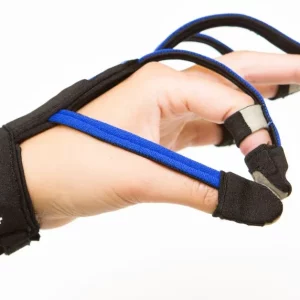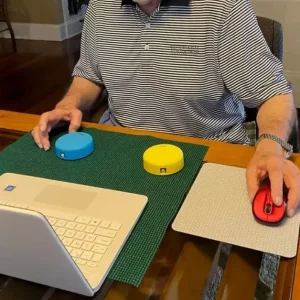Stroke survivors often require frequent physical therapy, occupational therapy, or speech therapy rehabilitation appointments. Thankfully, more rehabilitation clinics are incorporating stroke telerehabilitation services into their program offerings.
This can allow individuals to participate in therapy despite transportation concerns and other barriers, such as time constraints, resource limitations, geographical challenges, or compliance with traditional therapy models.
But the real question is does stroke telerehabilitation work? In other words, what exactly does stroke telerehabilitation include and is it enough for the needs of stroke survivors? Let’s take a look!
Jump to a section:
What is Stroke Telerehabilitation?
Benefits of Stroke Telerehabilitation
Drawbacks of Stroke Telerehabilitation
Telerehabilitation for Stroke Recovery
Making The Most of Your Tools at Home
Telerehabilitation for Stroke Survivors: Does it Work?
Telerehabilitation Research in Post-Stroke Therapy
Katy’s Recovery Story
What is Stroke Telerehabilitation?
Telerehabilitation involves delivering traditional rehabilitation services, such as physical, occupational, and/or speech therapy, using virtual technology. Starting around the time live video-conferencing became available in the 1990s, telerehabilitation gradually gained popularity.
In 1997, there were at least 3 telerehabilitation programs. Since then, and especially after the COVID-19 pandemic, telerehabilitation has greatly expanded. In fact, one study found that nearly 50,000 individuals in the US used telerehabilitation between 2020-2021. Some of these may be as simple as having regular checkins with your therapist over video call. However, other programs go as far to provide direction for exercise and more over the call.
Yet, stroke telerehabilitation doesn’t change the unique needs of stroke survivors trying to recover. Each patient is unique, and their treatment should be, too. Telerehabilitation’s virtual approach enables stroke survivors to receive remote rehabilitation therapy right in their own homes, which can allow them to practice tasks and exercises using tools in their home environment.
A teletherapist will customize therapy according to each patient’s individual needs using the tools available to them. To optimize recovery outcomes, therapists will often focus on repetitive practice. This boosts neuroplasticity, or the brain’s ability to rewire itself. Individuals often find telerehabilitation an engaging and effective way to pursue recovery after stroke.
Benefits of Stroke Telerehabilitation
Compared with conventional rehabilitation, which often occurs in a clinic setting, telerehabilitation has many benefits. For example, since telerehabilitation can be completed at home, concerns regarding transportation are eliminated. This can help improve adherence to therapy which can improve functional outcomes through a variety of methods including:
- Easy to integrate into daily routine
- Overcomes geographic barriers to healthcare access
- Efficient service delivery
- Allows for realistic practice of skills in the individual’s home environment
Many therapy clinics try to simulate the home environment when practicing tasks such as getting in and out of bed or meal preparation. Rather than trying to carry over skills learned in a clinic to their home environments, individuals receiving stroke telerehabilitation are able to use their own beds, kitchens, living areas, and possessions to practice these tasks.
This, in addition to its increased accessibility, can make telerehabilitation very appealing.
Drawbacks of Stroke Telerehabilitation
Although there are many advantages of using telerehabilitation for stroke recovery, there are a few drawbacks. Potential challenges individuals may face with telerehabilitation include:
- Lack of equipment, software, and space for home-based exercises
- Insufficient internet capacity and/or speed
- Inability to provide hands on guidance, especially important for correcting form and addressing fall risks and other safety concerns
- Limited technology skills, especially among older adults
While these drawbacks are not applicable to everyone, they may be problematic for some individuals considering telerehabilitation.
Telerehabilitation for Stroke Recovery
Many stroke survivors find telerehabilitation engaging, rewarding and motivating. Flexible scheduling can make therapy appointments fit easily into the patient’s day, while working from the comfort of home allows for participation in realistic functional activities.
Examples of telerehabilitation interventions for stroke recovery include:
- Using a device, such as the MusicGlove, to improve hand function, followed by practicing an activity like grasping dishes and silverware with the affected hand to set the table. This integrates the motivational aspects of technology alongside functional practice in the patient’s own kitchen using their own dinnerware.
- Practicing leg range of motion exercises, followed by working on moving from sitting at the edge of the bed to lying down. Practicing these activities in the patient’s own home environment can allow therapists to visualize the situation, work through any challenges, and provide personalized feedback.
- Individuals may work on improving language skills through a virtual reality program with their therapist, then practice using these skills in a conversation with a family member, with the therapist providing cues as needed. If there are areas the patient continues to have trouble with, the therapist can plan to present similar situations through the virtual reality program during the next therapy session.
These examples make it easy to see how telerehabilitation can certainly have advantages. The opportunity to practice real-life scenarios in your own home with immediate therapist feedback can be very beneficial. Rather than practicing a specific skill at a clinic and hoping to use it at home, telerehabilitation allows for real-time practice and problem solving, promoting improved function.
Making The Most of Your Tools at Home
Stroke telerehabilitation uses stroke rehab equipment and technology such as neurorehabilitation devices, robotics, or virtual reality. These tools can provide real-time information that helps your rehabilitation team monitor and track your progress and adjust treatment plans.
Stroke recovery requires consistency and high repetition. Therefore, therapists may use high-tech neurorehabilitation devices so patients can experience an optimized blend of technology and personalized therapy. These devices, such as Flint Rehab’s FitMi home therapy, provide immediate feedback to patients and therapists. Some devices also use smart technology to automatically adapt to the individual’s skill level, providing a just right challenge even as skills improve.
Between telerehab sessions, stroke recovery apps can help you get your daily therapy dose while keeping your recovery regimen fun and engaging to encourage consistency. Your therapy team will encourage you to practice your home exercise program between therapy sessions, and apps can be an especially helpful and fun way to do so.
Does Telerehabilitation for Stroke Survivors Work?
You may think telerehabilitation for post-stroke care is new, but it came into the limelight in 1999, and patients have been using telerehab for over a decade. Telerehabilitation appointments are easy to set up, giving patients improved access to rehab professionals, including physical, occupational, and speech therapists.
Shifting the focus to home-based therapy helps to ensure that rehabilitation efforts are relevant to the patient’s real-life needs and goals. During a telerehabilitation visit, therapists review and update exercises with the patients. At that time, the patient and therapist discuss progress, review exercises, and demonstrate and perform the exercises or activities together. Telerehabilitation programs are increasingly focused on helping patients achieve functional outcomes, such as performing everyday activities in their homes, rather than just improving affected skills.
But you want to know: Does telerehabilitation really work for stroke recovery? Let us outline what the research shows!
Post Stroke Therapy – What the Research Says About Stroke Telerehabilitation
Although it sounds intriguing, many wonder whether telerehabilitation really works for stroke recovery. According to researchers, stroke telerehabilitation can be equally or even more effective than face-to-face care.A review of 13 randomized controlled trials revealed that telerehabilitation may be as effective as usual care for improving motor function, ability to perform activities of daily living, independence, satisfaction, quality of life, and other important outcomes after stroke.
Therefore, you can feel confident that telerehabilitation is backed by research and can help you make meaningful progress in your stroke recovery, just like in-person rehab sessions.
The following sections outline additional areas of research regarding the effectiveness of telerehabilitation after stroke.
Research in Motor Function
Recent studies highlight that activity-based telerehabilitation works just as well to achieve improvements in arm motor function. While there are fewer reviews regarding the effectiveness of telerehabilitation for lower body function, some studies suggest telerehabilitation may have positive impacts on mobility, lower extremity impairment, strength, and goal attainment.
In a recent systematic review, telerehabilitation is shown to have either better or equal effects on motor function, higher cortical function, and depression in patients, with significant differences observed in 8 out of 22 studies compared with control groups.
Research in Cognition and Language
Studies have also found that telerehabilitation can improve cognitive outcomes, such as working memory and processing speed, perhaps even more so than conventional therapy. For those with post-stroke aphasia, telerehabilitation may also promote language skills, such as auditory comprehension, naming accuracy, and functional communication skills.
Research in Patient Satisfaction
Research shows that individuals are equally satisfied with telerehabilitation as in-person therapy, especially because of the added convenience. Moreover, the comfort of home-based sessions also strengthens adherence to stroke recovery treatment. Patient satisfaction is key in maintaining motivation, compliance to treatment and stamina in the recovery process after a stroke.
Caregiver Benefits
As a stroke survivor, having a supportive caregiver by your side can make a world of difference on your journey to recovery. Telerehabilitation programs don’t just benefit you – research shows they also help your caregivers. Research reports that family caregivers benefit from telerehabilitation because it helps improve caregiver burden, knowledge, and competence.
While there is still more research that can be done to solidify the effectiveness of stroke telerehabilitation, many current studies report positive results.
In the following section, we’ll share an inspiring story of Katy—a reminder that meaningful recovery is possible after stroke with determination and the proper support. We hope Katy’s tale of resilience will motivate you to keep pushing forward, one step at a time.
Katy’s Recovery Story with Stroke Telerehab
We understand that recovering from a stroke can feel overwhelming at times. But you don’t have to go through this challenging experience alone. Many stroke survivors before you have traveled this road and reclaimed their independence through perseverance and the proper care.
Reading their inspiring stories can provide motivation and hope for your journey. Whether your victory is opening a cabinet to cook for your family or climbing the stairs to sleep in your own bed, every achievement is worth celebrating.
Here is Katy’s stroke recovery story:
Katy is a resilient stroke survivor committed to regaining independence in her daily life. Faced with the challenge of using her affected arm, Katy embarked on a journey of recovery with the support of her occupational therapist via stroke telerehabilitation. Over time, Katy tackled a simple yet significant goal—opening her kitchen drawer using her affected arm. With consistency and repetition, she practiced and translated these movements through virtual guidance into her routine, marking a triumph for her and telerehabilitation methodology.
This achievement underscored a personal victory for Katy and shows the potential of telerehabilitation in empowering stroke survivors on their path to independence.
Understanding Stroke Telerehabilitation
Telerehabilitation marks a profound shift in how survivors pursue recovery. Its effectiveness is backed by science, celebrated by patients, and driven by the human touch of expert therapists guiding each session virtually. Deciding if telerehab is right for you depends on a few factors such as your comfort with technology and the type of interaction you prefer with your therapists.
Talk with your doctor to find out more about whether telerehabilitation may be right for you
Additional Resources
Remote Rehabilitation for Stroke Patients: What Sets it Apart?
Why “One More Time” Matters in Stroke Rehab










